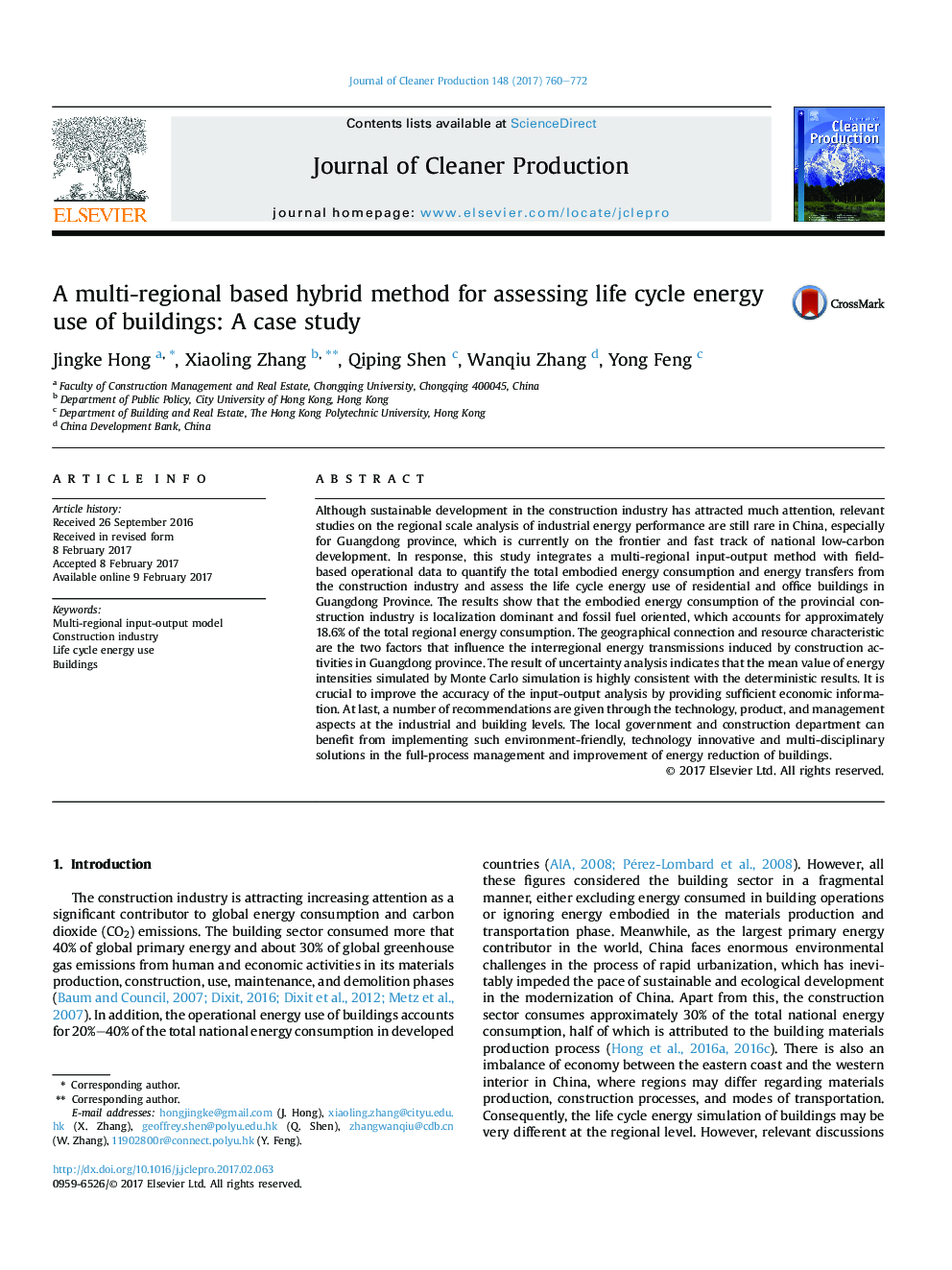| کد مقاله | کد نشریه | سال انتشار | مقاله انگلیسی | نسخه تمام متن |
|---|---|---|---|---|
| 5480235 | 1522105 | 2017 | 13 صفحه PDF | دانلود رایگان |
عنوان انگلیسی مقاله ISI
A multi-regional based hybrid method for assessing life cycle energy use of buildings: A case study
ترجمه فارسی عنوان
یک روش ترکیبی مبتنی بر چند منطقه ای برای ارزیابی مصرف انرژی ساختمان ها: مطالعه موردی
دانلود مقاله + سفارش ترجمه
دانلود مقاله ISI انگلیسی
رایگان برای ایرانیان
کلمات کلیدی
مدل ورودی-خروجی چند منطقه ای، صنعت ساخت و ساز، استفاده از چرخه زندگی، ساختمان ها،
ترجمه چکیده
اگرچه توسعه پایدار در صنعت ساخت و ساز توجه زیادی را به خود جلب کرده است، مطالعات مربوط به تجزیه و تحلیل مقیاس منطقه ای عملکرد انرژی صنعتی هنوز در چین، به ویژه در استان گوانگدونگ، که در حال حاضر در مرز و سرعت پیشرفت ملی توسعه کم کربن هستند، هنوز نادر است. در پاسخ، این مطالعه یک روش ورودی-خروجی چند منطقه ای با داده های عملیاتی مبتنی بر میدان را برای اندازه گیری کل مصرف انرژی تجدید شده و انتقال انرژی از صنعت ساخت و ساز و ارزیابی استفاده از انرژی مصرفی ساختمان های مسکونی و اداری در استان گوانگدونگ، متصل می کند. نتایج نشان می دهد که مصرف انرژی تجدید شده در صنعت ساخت و ساز استان، موضع گیری غالب و سوخت فسیلی است که تقریبا 18.6 درصد کل مصرف انرژی منطقه ای را تشکیل می دهد. اتصال جغرافیایی و ویژگی منابع، دو عامل است که بر انتقال انرژی بین منطقه ای ناشی از فعالیت های ساختمانی در استان گوانگدونگ تاثیر می گذارد. نتیجه تحلیل عدم قطعیت نشان می دهد که میانگین شدت انرژی شبیه سازی شده توسط شبیه سازی مونت کارلو با نتایج قطعی سازگار است. مهم است که با ارائه اطلاعات اقتصادی کافی، صحت تحلیل ورودی-خروجی را بهبود بخشد. در نهایت، تعدادی از توصیه ها از طریق جنبه های فن آوری، محصول و مدیریت در سطوح صنعتی و ساختمان داده می شود. دولت محلی و اداره ساخت و ساز می تواند از اجرای چنین راه حل های سازگار با محیط زیست، فن آوری نوآورانه و چند رشته ای در مدیریت کامل و بهبود کاهش انرژی ساختمان ها بهره مند شود.
موضوعات مرتبط
مهندسی و علوم پایه
مهندسی انرژی
انرژی های تجدید پذیر، توسعه پایدار و محیط زیست
چکیده انگلیسی
Although sustainable development in the construction industry has attracted much attention, relevant studies on the regional scale analysis of industrial energy performance are still rare in China, especially for Guangdong province, which is currently on the frontier and fast track of national low-carbon development. In response, this study integrates a multi-regional input-output method with field-based operational data to quantify the total embodied energy consumption and energy transfers from the construction industry and assess the life cycle energy use of residential and office buildings in Guangdong Province. The results show that the embodied energy consumption of the provincial construction industry is localization dominant and fossil fuel oriented, which accounts for approximately 18.6% of the total regional energy consumption. The geographical connection and resource characteristic are the two factors that influence the interregional energy transmissions induced by construction activities in Guangdong province. The result of uncertainty analysis indicates that the mean value of energy intensities simulated by Monte Carlo simulation is highly consistent with the deterministic results. It is crucial to improve the accuracy of the input-output analysis by providing sufficient economic information. At last, a number of recommendations are given through the technology, product, and management aspects at the industrial and building levels. The local government and construction department can benefit from implementing such environment-friendly, technology innovative and multi-disciplinary solutions in the full-process management and improvement of energy reduction of buildings.
ناشر
Database: Elsevier - ScienceDirect (ساینس دایرکت)
Journal: Journal of Cleaner Production - Volume 148, 1 April 2017, Pages 760-772
Journal: Journal of Cleaner Production - Volume 148, 1 April 2017, Pages 760-772
نویسندگان
Jingke Hong, Xiaoling Zhang, Qiping Shen, Wanqiu Zhang, Yong Feng,
